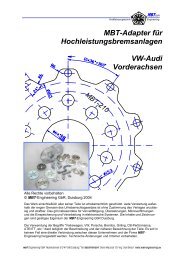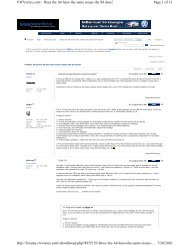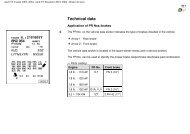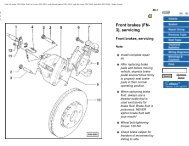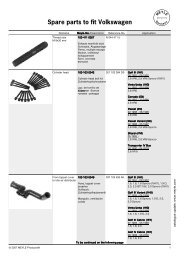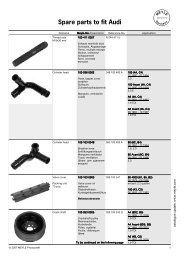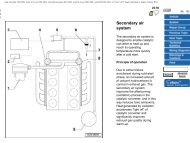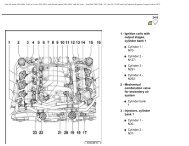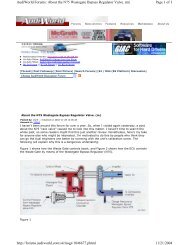VW MKII A2 MK2 Golf Jetta Fox Service Manual - VAGLinks.com
VW MKII A2 MK2 Golf Jetta Fox Service Manual - VAGLinks.com
VW MKII A2 MK2 Golf Jetta Fox Service Manual - VAGLinks.com
Create successful ePaper yourself
Turn your PDF publications into a flip-book with our unique Google optimized e-Paper software.
11•2 Bodywork and fittings<br />
If the vehicle is very dirty, especially<br />
underneath or in the engine <strong>com</strong>partment, it is<br />
tempting to use one of the pressure washers or<br />
steam cleaners available on garage forecourts.<br />
Whilst these are quick and effective, especially<br />
for the removal of the accumulation of oily grime<br />
which sometimes is allowed to be<strong>com</strong>e thick in<br />
certain areas, their usage does have some<br />
disadvantages. If caked-on dirt is simply<br />
blasted off the paintwork, its finish soon<br />
be<strong>com</strong>es scratched and dull and the pressure<br />
can allow water to penetrate door and window<br />
seals and the lock mechanisms. If the full force<br />
of such a jet is directed at the vehicle’s<br />
underbody, the wax-based protective coating<br />
can easily be damaged and water (with<br />
whatever cleaning solvent is used) could be<br />
forced into crevices or <strong>com</strong>ponents that it<br />
would not normally reach. Similarly, if such<br />
equipment is used to clean the engine<br />
<strong>com</strong>partment, water can be forced into the<br />
<strong>com</strong>ponents of the fuel and electrical systems<br />
and the protective coating can be removed that<br />
is applied to many small <strong>com</strong>ponents during<br />
manufacture; this may therefore actually<br />
promote corrosion (especially inside electrical<br />
connectors) and initiate engine problems or<br />
other electrical faults. Also, if the jet is pointed<br />
directly at any of the oil seals, water can be<br />
forced past the seal lips and into the engine or<br />
transmission. Great care is required, therefore, if<br />
such equipment is used and, in general, regular<br />
cleaning by such methods should be avoided.<br />
A much better solution in the long term is<br />
just to flush away as much loose dirt as<br />
possible using a hose alone, even if this leaves<br />
the engine <strong>com</strong>partment looking dirty. If an oil<br />
leak has developed, or if any other<br />
accumulation of oil or grease is to be removed,<br />
there are one or two excellent grease solvents<br />
available, which can be brush applied. The dirt<br />
can then be simply hosed off. Take care to<br />
replace the wax-based protective coat, if this<br />
was affected by the solvent.<br />
Normal washing of the bodywork is best<br />
carried out using cold or warm water with a<br />
proprietary car shampoo. Remove dead<br />
insects with a proprietary cleaning product;<br />
tar spots can be removed either by using<br />
white spirit, followed by soapy water to<br />
remove all traces of spirit, or by using a tar<br />
remover. Try to keep water out of the bonnet<br />
air inlets and check afterwards that the heater<br />
air inlet box drain tube is clear so that any<br />
water has drained out of the box.<br />
After washing the paintwork, wipe off with a<br />
chamois leather to give an unspotted clear<br />
finish. A coat of clear protective wax polish,<br />
will give added protection against chemical<br />
pollutants in the air. If the paintwork sheen<br />
has dulled or oxidised, use a cleaner/polisher<br />
<strong>com</strong>bination to restore the brilliance of the<br />
shine. This requires a little effort, but such<br />
dulling is usually caused because regular<br />
washing has been neglected. Care needs to<br />
be taken with metallic paintwork, as special<br />
non-abrasive cleaner/polisher is required to<br />
avoid damage to the finish.<br />
Brightwork should be treated in the same<br />
way as paintwork.<br />
Windscreens and windows can be kept<br />
clear of the smeary film which often appears,<br />
by the use of a proprietary glass cleaner.<br />
Never use any form of wax or chromium<br />
polish on glass.<br />
Vehicle interior<br />
Mats and carpets should be brushed or<br />
vacuum cleaned regularly to keep them free of<br />
grit. If they are badly stained remove them<br />
from the vehicle for scrubbing or sponging<br />
and make quite sure they are dry before<br />
refitting.<br />
Where leather upholstery is fitted it should<br />
be cleaned only if necessary, using either a<br />
mild soap (such as saddle soap) or a<br />
proprietary leather cleaner; do not use strong<br />
soaps, detergents or chemical cleaners. If the<br />
leather is very stained, seek the advice of a<br />
<strong>VW</strong> dealer. Fabric-trimmed seats and interior<br />
trim panels can be kept clean by wiping with a<br />
damp cloth and a proprietary cleaner. If they<br />
do be<strong>com</strong>e stained (which can be more<br />
apparent on light coloured upholstery) use a<br />
little liquid detergent and a soft nail brush to<br />
scour the grime out of the grain of the<br />
material. Do not forget to keep the headlining<br />
clean in the same way as the (fabric)<br />
upholstery.<br />
When using liquid cleaners of any sort<br />
inside the vehicle, do not over-wet the<br />
surfaces being cleaned. Excessive damp<br />
could get into the seams and padded interior<br />
causing stains, offensive odours or even rot. If<br />
the inside of the vehicle gets wet accidentally<br />
it is worthwhile taking some trouble to dry it<br />
out properly, particularly where carpets are<br />
involved. Do not leave oil or electric heaters<br />
inside the vehicle for this purpose.<br />
3 Minor body damage - repair<br />
Repair of minor scratches in<br />
bodywork<br />
2<br />
If the scratch is very superficial and does<br />
not penetrate to the metal of the bodywork,<br />
repair is very simple. Lightly rub the area of<br />
the scratch with a paintwork renovator, or a<br />
very fine cutting paste to remove loose paint<br />
from the scratch and to clear the surrounding<br />
bodywork of wax polish. Rinse the area with<br />
clean water.<br />
Apply touch-up paint or a paint film, to the<br />
scratch using a fine paint brush. Continue to<br />
apply fine layers of paint until the surface of<br />
the paint in the scratch is level with the<br />
surrounding paintwork. Allow the new paint at<br />
least two weeks to harden, then blend it into<br />
the surrounding paintwork by rubbing the<br />
scratch area with a paintwork renovator, or a<br />
very fine cutting paste. Finally apply wax<br />
polish.<br />
1081 <strong>VW</strong> <strong>Golf</strong> & <strong>Jetta</strong><br />
Where the scratch has penetrated right<br />
through to the metal of the bodywork, causing<br />
the metal to rust, a different repair technique<br />
is required. Remove any loose rust from the<br />
bottom of the scratch with a penknife, then<br />
apply rust inhibiting paint, to prevent the<br />
formation of rust in the future. Using a rubber<br />
or nylon applicator fill the scratch with<br />
bodystopper paste. If required, this paste can<br />
be mixed with cellulose thinners, to provide a<br />
very thin paste which is ideal for filling narrow<br />
scratches. Before the stopper-paste in the<br />
scratch hardens, wrap a piece of smooth<br />
cotton rag around the top of a finger. Dip the<br />
finger in cellulose thinners, and quickly sweep<br />
it across the surface of the stopper-paste in<br />
the scratch; this will ensure that the surface of<br />
the stopper-paste is slightly hollowed. The<br />
scratch can now be painted over as described<br />
earlier in this Section.<br />
Repair of dents in bodywork<br />
When deep denting of the vehicle’s<br />
bodywork has taken place, the first task is to<br />
pull the dent out, until the affected bodywork<br />
almost attains its original shape. There is little<br />
point in trying to restore the original shape<br />
<strong>com</strong>pletely, as the metal in the damaged area<br />
will have stretched on impact and cannot be<br />
reshaped fully to its original contour. It is<br />
better to bring the level of the dent up to a<br />
point which is about 3 mm below the level of<br />
the surrounding bodywork. In cases where the<br />
dent is very shallow anyway, it is not worth<br />
trying to pull it out at all. If the underside of the<br />
dent is accessible, it can be hammered out<br />
gently from behind, using a mallet with a<br />
wooden or plastic head. Whilst doing this,<br />
hold a suitable block of wood firmly against<br />
the outside of the panel to absorb the impact<br />
from the hammer blows and thus prevent a<br />
large area of the bodywork from being<br />
“belled-out”.<br />
Should the dent be in a section of the<br />
bodywork which has a double skin or some<br />
other factor making it inaccessible from<br />
behind, a different technique is called for. Drill<br />
several small holes through the metal inside<br />
the area - particularly in the deeper section.<br />
Then screw long self-tapping screws into the<br />
holes just sufficiently for them to gain a good<br />
purchase in the metal. Now the dent can be<br />
pulled out by pulling on the protruding heads<br />
of the screws with a pair of pliers.<br />
The next stage of the repair is the removal<br />
of the paint from the damaged area and from<br />
an inch or so of the surrounding sound<br />
bodywork. This is ac<strong>com</strong>plished most easily<br />
by using a wire brush or abrasive pad on a<br />
power drill, although it can be done just as<br />
effectively by hand using sheets of abrasive<br />
paper. To <strong>com</strong>plete the preparation for filling,<br />
score the surface of the bare metal with a<br />
screwdriver or the tang of a file, or<br />
alternatively, drill small holes in the affected<br />
area. This will provide a really good key for the<br />
filler paste. To <strong>com</strong>plete the repair see the<br />
Section on filling and respraying.



